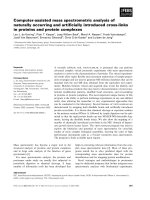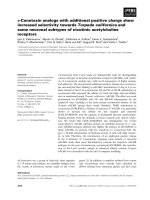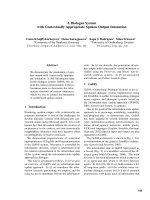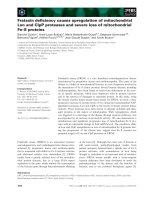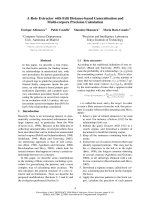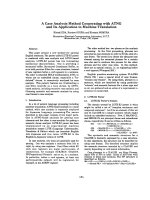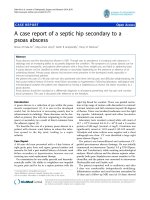Báo cáo khoa học: "A colliding maxillary sinus cancer of adenosquamous carcinoma and small cell neuroendocrine carcinoma - a case report with EGFR copy number analysis" pot
Bạn đang xem bản rút gọn của tài liệu. Xem và tải ngay bản đầy đủ của tài liệu tại đây (2.37 MB, 5 trang )
CAS E REP O R T Open Access
A colliding maxillary sinus cancer of
adenosquamous carcinoma and small cell
neuroendocrine carcinoma - a case report with
EGFR copy number analysis
Shiang-Fu Huang
1*
, Wen-Yu Chuang
2
, Sou-De Cheng
3
, Li-Jen Hsin
1
, Li-Yu Lee
2
, Huang-Kai Kao
4
Abstract
Background: Small cell neuroendocrine carcinoma (SNEC) of maxillary sinus is a rare and aggressive malignancy. A
tumor with squamous cell carcinoma, adenocarcinoma and SNEC co-existence is extremely rare.
Case presentation: We present a colliding tumor of squamous cell, adenocarcinoma and SNEC in maxillary sinus.
The clinical features, diagnosis and EGFR flourescence in situ hybridization (FISH) study are presented. A 52-year-old
female had a 1-month history of progressing left cheek swelling and purulent rhinorrhea. Magnetic resonance
imaging showed a tumor involving left maxilla and orbital floor. Excision of tumor was done and the defect was
reconstructed with free flap. The pathology revealed a malignant tumor composed of squamous cell carcinoma,
adenocarcinoma and SNEC components. EGFR FISH study showed no gene amplification in 3 components of this
tumor. The tumor progressed rapidly and the patient expired at 8 months after surgery.
Conclusion: A colliding tumor of squamous cell, adenocarcinoma and neuroendocrine carcinoma in maxillary
sinus was aggressive in behavior and the treatment response was poor due to the complexity of tumor.
Introduction
Carcinoma of the paranasal sinuses accounts for about
0.3% of all cancers [1]. Most of the malignancies in
paranasal sinus is squamous cell carc inoma (SCC) and
fol lowed by adenocarcinoma. Small cell neuroendocrine
carcinoma (SNEC) is a rare tumor in head and neck
region and it occurs most frequently in larynx [2]. Para-
nasal sinuses are uncommon primary sites for the
occurrence of extrapulmonary SNECs. Only small series
and case reports were available to date for primary sino-
nasal tract SNEC [3]. Foci of squamous or glandular dif-
ferentiation in SNECs were occasionally noted [4,5]. The
collision of three components (squamous cell, adenocar-
cinoma and neuroendocrine cells) in a solid tumor was
very rare. Only two reports of combined adenosqua-
mous and large-cell neuroendocrine carcinoma were
reported in the literature [6,7].
Despite extensive treatment, SNECs in head and neck
had poor prognosis and high rates of recurrence and dis-
tant metastasis [3]. Epidermal growth factor receptor
(EGFR) antagon ists and monoclon al antibodies we re
found to have promising results in non-small lung cancer
and colon cancer [8,9]. In head and neck SCC, several
EGFR inhibitors have been studied alone or in combina-
tion with cisplatin/carboplatin and were found to have
modest response rates [10,11]. The target therapies pro-
vide new options to traditional therapies. In a tumor of
three different histologies (squamous cell, adenocarci-
noma and neuroendocrine cells) and aggressive in beha-
vior, we investigated the EGFR co py number by
fluorescence in situ hybridization (FISH ) in each compo-
nent of the tumor. The feasibility of EGFR target therapy
in such a malignant tumor was discussed in the text.
Case Report
A 52-year-old female with history of hypertension and
type II diabetes mellitus, came to our clinic with the chief
complaint of left cheek swelling and persistent purulent
* Correspondence:
1
Department of Otolaryngology, Chang Gung Memorial Hospital and Chang
Gung University, Taiwan
Full list of author information is available at the end of the article
Huang et al. World Journal of Surgical Oncology 2010, 8:92
/>WORLD JOURNAL OF
SURGICAL ONCOLOGY
© 2010 Huang e t al; licensee BioMed Central Ltd. This is an Open Access article distributed under the terms of the Cre ative Commons
Attribution License ( which permits unrestricted use, distribut ion, and reproduction in
any medium, provided the original work is properly cited.
mucoid nasal discharge from left nostril for one month.
Physical examination revealed a nasal tumor and a bul-
ging mass in hard palate. Biopsy u nder sinoscope was
done and the pathology showed a SNEC with positive
neuron-specific enolase, CD 56, synaptophysin, Cam 5.2
and focally AE1:AE3 from immunohistochemistry. Com-
puted tomography (CT) scan and MRI (Figure 1)
revealed a destructive lesion involving all walls of left
maxillary sinus. There was no evidence of distant metas-
tasis from bone scan and abdominal sonography. Left
total maxillectomy was performed with free flap recon-
struction (left anterior lateral thigh flap) following the
resection. Microscopically, bony invasion was evident
and the final pathology revealed a mali gnant tumor com-
posed of SNEC, SCC and adenocarcinoma (Figure 2).
Adjuvant chemotherapy with FT-207, leukovorin, and
cisplatin were given. Regional recurrence at bilateral neck
lymph nodes occurred at 2 months and lung metastasis
at 6 months after surgery. The patient expired later due
to sepsis and had an overall survival of 8 months after
diagnosis.
FISH Assay and Analysis
EGFR copy numbers were investigated by FISH using the
LSI EGFR SpectrumOrange/CEP 7 SpectrumGreen probe
(Vysis; Abbott Laboratories, Downers Grove, IL) and this
was carried out using the manufacturer’sprotocols.In
brief, section slides were incubated at 56°C overnight,
deparaffined, dehydrated, and treated with 0.2 N HCl
(pH 2.5) for 20 min. This was followed by 1 M sodium
thiocyanate (Sigma-Aldrich Corp., St. Louis, MO) in 1 M
Tris (pH 8.0) at 82°C for 20 min, and then the specimens
were digested with 0.4% pepsin (Sigma-Aldrich Corp., St.
Louis, MO) in 0.9% NaCl (pH 2.35) for 15 min. The sam-
ples were briefly rinsed with ddH
2
Oand2×SSC
between steps. After fixation in 4% formaldehyde for
5 min, each slide had the probe set applied to the selected
are a, and the hybridization area was cov ered with a plas-
tic coverslip and sealed with a glue gun before heating at
75°C for 10 min in an OmniGene syste m (Hybaid Ltd.,
Middlesex, United Kingdom) to allow co-dena turation of
the chromosomal and probe DNAs. Hybridization was
then carried out in a humidified oven at 37°C for
18 hours, and this was followed by postwashing in 0.3%
Nonidet P40 (BDH, England) in 2 × SSC at 55°C for
4 min, in 2 × SSC at 55°C for 5 min, and finally twice in
2 × SSC at room temperature for 5 min. After being
counterstained with DAPI for 5 min, the slides were
mounted with Vectashield mounting medium (Vector
Laboratories, Burlingame, CA), and scored under an epi-
fluorescence microscope using a Plan Neofluar 100 ×
objective (Axiophot, Zeiss, Germany) with FITC/TRITC
dual and DAPI/FITC/TRITC riple pass filters (Chroma
Technology Corp., Bellows Falls, VT).
Figure 1 Post-gadolinium contrast-enhanced T1-weighted coronal magnetic resonance imaging (MRI), with fat saturation, showed an
enhancing and destructive mass with indistinct borders in left maxillary sinus. (A) Coronal view. (B) Axial view.
Huang et al. World Journal of Surgical Oncology 2010, 8:92
/>Page 2 of 5
The EGFR copy number was mostly monosomy in the
ductal component, disomy in the neuroendocrine com-
ponent and some trisomy in the squamous cell compo-
nent (Figure 3). No EGFR amplification was found in
the FISH analysis.
Discussion
Most of maxillary sinus cancer was SCC and adenocar-
cinoma. S NEC of the sinonasal region is the least com-
mon of the sinonasal carcinomas with neuroendocrine
differentiation. The SCC or adenocarcinoma in maxillary
sinus developed from the lining mucosal epithelium or
metaplasia. The histogenesis of the neuroendocrine
differentiated tumors is not clear. Whether those cells
stem from a common pluripotent precursor or from
metaplastic neuroendocrine cells is still unclear. It has
been postulated that, outside the lung, this tumor is
derived from the neuroendocrine APUD cells, which are
widely distributed in the body. The tu mors are com-
posed of small-sized regular cells arranged in broad
sheets, nests, and cords. Many of the cells contain cri-
briform nuclei with a fine reticular chromatin pattern
and small to moderate amounts of cytoplasm [12].
Immunohistochemical study is essential to make an ade-
quate differential diagnosis from other malignant tumors
such as lymphoma, rhabdomyosarcoma, undifferenti ated
nasopharyngeal carcinoma, and undifferentiated sinona-
sal carcinoma. SNEC has been reported to stain strongly
with synaptophysin and CD56 nerve cell adhesion mole-
cule and weakly with chromogranin A and CAM 5.2/
AE-1 [13].
Yazawa et al. had investigated the clonality of colliding
tumor which composed of adenocarcinoma, SCC and
large cell neuroendocrine carcinoma [7]. The clonality
Figure 2 A. Histologic appearance of combinations of small, ductal and squamous cell ular components of the tumor.(H&E,x100)
B. Transitional area between squamous cell carcinoma and neuroendocrine cells. (H & E, x200) C. Transitional region between glandular and
neuroendocrine components. (H & E, x200).
Huang et al. World Journal of Surgical Oncology 2010, 8:92
/>Page 3 of 5
results were similar in adenomatous and squamous
components and different in neuroendocrine compo-
nent. There were some limitations in that study due to
possible DNA fragmentations in formalin fixed tissues.
However, it confirmed the adenomatous and squamous
components were the same origin and classified it as a
colliding tumor of adenosquamous carcinoma (ASC)
and neuroendocrine carcinoma. In the literature, ASC is
an unusual neoplasm and often misdiagnosed [14]. In
our patient, the colliding tumor could originate from a
mix ture of ASC and the SNEC which gives the tumor a
feature of 3 different histologies.
The treatment of SNECs varied considerably over time
which includes surgery followed by radiotherapy, concur-
rent chemo-radiotherapy with or without surgery, and
chemotherapy with cisplatin and eoposide followed by
radiation or surgery [15]. No consensus yet exists about its
treatment. The management of maxillary sinus ASC is
also controversial due to its rarity. The prognosis in cases
of head and neck SNEC and ASC is very poor because of
the high metastatic rate observed. [3,14] In our patient,
the tumor recurred and metastasized rapidly after surgery.
Its response to chemotherapy was poor. The diverse com-
ponents of the tumor could possibly account for its non-
responsiveness to chemotherapy and aggressive behaviors.
Recently, EGFR targeting agents such as Cetuximab
(C225, Erbitux™), a human-murine chimeric monoclonal
antibody, gefitinib and erlotinib were developed. They
are less toxic in side effects than cheomotherapies. In
locoregionally advanced head and neck SCC, concomi-
tant high-dose radiotherapy plus Cetuximab had been
shown to improve locoregional control and reduces
mortality [16]. In chemotherapy refractory head and
neck cancers, some are r esponsiv e to EGFR target treat-
ment. However, from EGFR copy number analysis in
each component of the tumor, no EGFR amplification
was found. EGFR targeting agents might have limited
roles in this rare tumor.
Figure 3 EGFR gene FISH analysis. The field was observed by the triple band filter (1000×). (A) Mostly monosomy in ductal cells. (B) Both
disomy and monosomy in neuroendocrine cells. (C) Some cells with increased EGFR copy number in squamous cell components.
Huang et al. World Journal of Surgical Oncology 2010, 8:92
/>Page 4 of 5
Conclusion
A colliding malignant tumor of SCC, adenocarcinoma
and SNEC is rare in head and neck malignancies. The
diagnosis of this tumor usually could be made after
excision of tumor. Both adenosquamous carcinoma and
SNEC have aggressive behaviors. The colliding tumor of
these components also carries a poor prognosis. EGFR
copy numbers in all three histologies were not increased
and the efficacy of anti-EGFR target therapy could be
limited in this rare malignancy.
Consent
Written informed consent was obtained from the patient
for publication of this case report and accompanying
images. A copy of the written consent is available for
review by the Editor-in-Chief of this journal.
Acknowledgements
We thank Professor Ling-Ling Hsieh from Chang Gung University for her
valuable advice and assistance. This study was supported by Grant
CMRPG340381, CMRPG360701, CMRPG360851 and CMRPG371511 from
Chang Gung Memorial Hospital, Grant NSC99-2314-B-182A-036-MY3 from
the National Science Council and Grant DOH99-TD-C-111-006 from the
Department of Health, Executive Yuan, ROC.
Author details
1
Department of Otolaryngology, Chang Gung Memorial Hospital and Chang
Gung University, Taiwan.
2
Department of Pathology, Chang Gung Memorial
Hospital and Chang Gung University, Taiwan.
3
Department of Anatomy,
Chang Gung University, Tao-Yuan, Taiwan.
4
Department of Plastic Surgery,
Chang Gung Memorial Hospital and Chang Gung University, Taiwan.
Authors’ contributions
HSF and HLJ conceived the idea for the manuscript, conducted a literature
search, and drafted the manuscript. HSF performed surgery, obtained images
and critically write the manuscript. CWY and LLY provided and reviewed
pathological images. CSD performed flourescence in-situ hybridization study.
HLJ and KHK critically revised the manuscript. All authors read and approved
the final manuscript.
Competing interests
The authors declare that they have no competing interests.
Received: 30 July 2010 Accepted: 20 October 2010
Published: 20 October 2010
References
1. Monserez D, Vlaminck S, Kuhweide R, Casselman J: Symmetrical ethmoidal
metastases from ductal carcinoma of the breast, suggesting
transcribrosal spread. Acta Otorhinolaryngol Belg 2001, 55:251-257.
2. Mills SE: Neuroectodermal neoplasms of the head and neck with
emphasis on neuroendocrine carcinomas. Mod Pathol 2002, 15 :264-278.
3. Mineta H, Miura K, Takebayashi S, Araki K, Ueda Y, Harada H, Misawa K:
Immunohistochemical analysis of small cell carcinoma of the head and
neck: a report of four patients and a review of sixteen patients in the
literature with ectopic hormone production. Ann Otol Rhinol Laryngol
2001, 110:76-82.
4. Chen DA, Mandell-Brown M, Moore SF, Johnson JT: “Composite” tumor–
mixed squamous cell and small-cell anaplastic carcinoma of the larynx.
Otolaryngol Head Neck Surg 1986, 95:99-103.
5. Gnepp DR: Small cell neuroendocrine carcinoma of the larynx. A critical
review of the literature. ORL J Otorhinolaryngol Relat Spec 1991, 53:210-219.
6. Noske A, Pahl S: Combined adenosquamous and large-cell
neuroendocrine carcinoma of the gallbladder. Virchows Arch 2006,
449:135-136.
7. Yazawa T, Ishii H, Ito T, Yoshiike Y, Ogawa N, Okudela K, Hayashi H,
Suzuki T, Mitsui H, Ikeda M, Kitamura H: Colliding primary lung cancers of
adenosquamous carcinoma and large cell neuroendocrine carcinoma.
Pathol Int 2003, 53:58-65.
8. Pao W, Miller V, Zakowski M, Doherty J, Politi K, Sarkaria I, Singh B, Heelan R,
Rusch V, Fulton L, Mardis E, Kupfer D, Wilson R, Kris M, Varmus H: EGF
receptor gene mutations are common in lung cancers from “never
smokers” and are associated with sensitivity of tumors to gefitinib and
erlotinib. Proc Natl Acad Sci USA 2004, 101:13306-13311.
9. Cappuzzo F, Finocchiaro G, Rossi E, Janne PA, Carnaghi C, Calandri C,
Bencardino K, Ligorio C, Ciardiello F, Pressiani T, Destro A, Roncalli M,
Crino L, Franklin WA, Santoro A, Varella-Garcia M: EGFR FISH assay predicts
for response to cetuximab in chemotherapy refractory colorectal cancer
patients. Ann Oncol 2008, 19:717-723.
10. Cohen EE, Rosen F, Stadler WM, Recant W, Stenson K, Huo D, Vokes EE:
Phase II trial of ZD1839 in recurrent or metastatic squamous cell
carcinoma of the head and neck. J Clin Oncol 2003, 21:1980-1987.
11. Soulieres D, Senzer NN, Vokes EE, Hidalgo M, Agarwala SS, Siu LL:
Multicenter phase II study of erlotinib, an oral epidermal growth factor
receptor tyrosine kinase inhibitor, in patients with recurrent or
metastatic squamous cell cancer of the head and neck. J Clin Oncol 2004,
22:77-85.
12. Rejowski JE, Campanella RS, Block LJ: Small cell carcinoma of the nose
and paranasal sinuses. Otolaryngol Head Neck Surg 1982, 90:516-517.
13. Avitia S, Osborne RF: Blindness: a sequela of sinonasal small cell
neuroendocrine carcinoma. Ear Nose Throat J 2004, 83:530-532.
14. Alos L, Castillo M, Nadal A, Caballero M, Mallofre C, Palacin A, Cardesa A:
Adenosquamous Carcinoma of the head and neck: criteria for diagnosis
in a study of 12 cases. Histopathology 2004, 44:570-579.
15. Babin E, Rouleau V, Vedrine PO, Toussaint B, de Raucourt D, Malard O,
Cosmidis A, Makaeieff M, Dehesdin D: Small cell neuroendocrine
carcinoma of the nasal cavity and paranasal sinuses. J Laryngol Otol 2006,
120:289-297.
16. Bonner JA, Harari PM, Giralt J, Azarnia N, Shin DM, Cohen RB, Jones CU,
Sur R, Raben D, Jassem J, Ove R, Kies MS, Baselga J, Youssoufian H,
Amellal N, Rowinsky EK, Ang KK: Radiotherapy plus cetuximab for
squamous-cell carcinoma of the head and neck. N Engl J Med 2006,
354:567-578.
doi:10.1186/1477-7819-8-92
Cite this article as: Huang et al.: A colliding maxillary sinus cancer of
adenosquamous carcinoma and small cell neuroendocrine carcinoma -
a case report with EGFR copy number analysis. World Journal of Surgical
Oncology 2010 8:92.
Submit your next manuscript to BioMed Central
and take full advantage of:
• Convenient online submission
• Thorough peer review
• No space constraints or color figure charges
• Immediate publication on acceptance
• Inclusion in PubMed, CAS, Scopus and Google Scholar
• Research which is freely available for redistribution
Submit your manuscript at
www.biomedcentral.com/submit
Huang et al. World Journal of Surgical Oncology 2010, 8:92
/>Page 5 of 5
